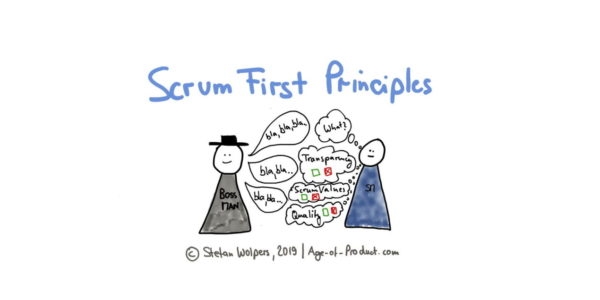— August 12, 2019
TL; DR: Scrum First Principles
Popularized by Elon Musk, utilizing first principles thinking to solve problems in an innovative, creative, and less biased way has proven popular in the tech community. Given that its sibling empiricism is an integral part of Scrum as a framework, applying Scrum first principles thinking is also a useful exercise.
Learn more about how to Elon Musk the Scrum Guide.

First Principles Thinking Explained by Elon Musk
Many people in the community initially learned about first principles thinking from the Elon Musk interview Kevin Rose hosted back in 2012. During the interview, Elon Musk explains the idea behind the first principles thinking and how it influenced him:
“So, the normal way that we conduct our lives is we reason by analogy. We’re doing this because it’s like something else that was done or it’s like other people are doing. […] It’s like, slight permutations, on a theme. […] And it’s, kind of mentally easier to reason by analogy rather than through first principles, but first principles is sort of a physics way of looking at the world. And what that really means is you kind of boil things down to the most fundamental truths. And say, okay what’re we sure is true, or as sure as possible is true, and then reason up from there.”
Watch the complete interview with Elon Musk here on Kevin Rose’s Youtube channel.

First Principles Thinking Background
Despite Elon Musk’s popularization of first principles thinking, the idea has been around for thousands of years. First-principles thinking alongside empiricism formed an essential part of ancient Greek philosophy, namely Aristotle‘s.
First-principles thinking and empiricism go hand-in-hand: If all knowledge is achieved through experience and can be described by categories and sub-categories, the smallest sub-categories in any domain—its fundamentals—can be referred to as first principles. Hence by going back and forth between experience and reason, we can break down problems into the smallest bits and reassemble them, thus building a structured body of knowledge that can unleash creative approaches to solving problems at hands.
The cognitive trap in applying first principles thinking is that moving incrementally forward does not necessarily mean that we are challenging traditional ways of thinking at the same time. We tend to imitate instead of innovating. The first advertising on websites looked very familiar—like ads in a newspaper. This old way of thinking, the inherited way led to an incrementalist approach, confining creativity instead of inspiring it. It took a few years before applying the information-printed-on-paper paradigm to the Internet was abandoned in favor of a new paradigm, for example, by placing sponsored links alongside search results.
While progress and innovation always rely on trial and error and continuous improvement, the benefit of first principles thinking is to overcome the imitation phase (faster) thus enabling us to address a problem from a different angle, freeing our mind to come up with better solutions and decisions.

Scrum First Principles
How can we apply first principles thinking to Scrum?
Regarding Scrum or the Scrum Guide, several candidates for Scrum first principles come to mind:
- Empiricism—and its pillars transparency, inspection, and adaptation—to deal with complexity
- Continuous improvement
- Scrum Values
- Self-organization
- Cross-functionality
- Regular delivery of valuable Product Increments
- Adherence to quality.
My pick for the Scrum first principles are:
- Transparency: It is the enabling principle to build trust among Scrum Team members, the stakeholders, and the organization in general. Without trust, no one can handle the complexity of product development.
- Self-organization: Problems are best solved by those closest to it; it is key to autonomy and thus accountability and overcoming the industrial paradigm.
- Scrum Values: Without courage, openness, and respect, there is no transparency.
- Quality: Nothing great has ever originated from substandard, mediocre work, and craftsmanship. (I consider “done” an attribute of quality.)
Whenever I run into a new challenging situation, I go back to my Scrum first principles to figure out a way to address the issue:
- Does the suggestion of the stakeholder improve transparency, thus helping the Scrum Team to address complexity in a better way?
- Does the instruction of the line manager support the self-organization of the Scrum Team?
- Is a behavior violating our Scrum Values?
- Shall we cut (quality) corners to help the CEO save face?
A helpful companion in this regard is the Scrum Guide Reordered which is based on about 90 percent of the text of the 2017 Scrum Guide, extending its original structure by adding additional categories. For example, you find all quotes that can be attributed to the role of the Scrum Master in one place. While the Scrum Guide is mainly focused on the three roles, five events, and three artifacts, I aggregated quotes on specific topics as well, for example, on self-organization, finance or technical debt.
Scrum First Principles — Conclusion
If nothing helps, read the manual Scrum Guide, and apply its first principles to the problem at hand. This may sound like reinventing the wheel regularly but has proven to be more effective than googling the universe for an answer. Utilizing Scrum not a set of practices and rules, but as a model based on first principles thinking is the only way to deliver the return on investment, every organization looks for when deciding to go with Scrum.
What is your pick of Scrum first principles? Please share with us in the comments.
Business & Finance Articles on Business 2 Community
(51)
Report Post


